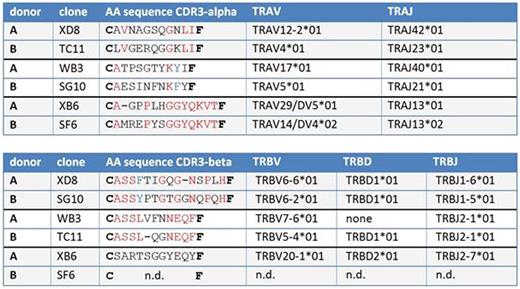Abstract
Background
Immunotherapy for CLL with new antibodies or T-cells with modified TCR relies on attractive targets. ROR1 is such a promising target since it is highly overexpressed in CLL. Chimeric antigen receptor engineered T cells and antibodies directed against the extracellular part of ROR1 have already been developed and tested in vitro or in animal models, but still there is no MHC-class I presented peptide serving as target structure for CD8+ T cells (with or without a genetically modified T cell receptor) available.
Aim
The aim of this study was (1) to identify an immunogenic MHC-class I presented ROR1 peptide, (2) to generate respective ROR1 peptide specific CD8+ T cell clones, and (3) to analyze the nucleotide sequence of the CDR3 region of the expressed alpha and beta T cell receptor chain.
Results
In mass spectrometric-based analyses of the HLA-ligandome a HLA-B*07 presented ROR1 peptide was identified in primary CLL cells of two patients. Six T cell clones specific for this particular ROR1-peptide were generated from single CD8+ T cells from 2 healthy individuals with 3 T cell clones generated from each donor. Functionality and specificity of those T cell clones were tested in cytotoxicity assays. All 6 dextramer+ CD8+ T cell clones lysed peptide loaded and HLA-B*07+ transduced K562 cells (kindly provided by Lorenz Jahn, [Jahn et al., Blood, 2015 Feb 5;125(6):949-58]). Two selected clones (XD8 and XB6) were tested for their cytotoxic potential against 2 ROR1+ HLA-B*07+ tumor cell lines (with the ROR1 peptide identified by mass spectrometry for both of them) and against 2 primary CLL cell samples. Tested clones showed a significant lysis of the respective target cells. CDR3 regions of the alpha and beta T cell receptor chain were sequenced on a single cell level. The CDR3 alpha region from each of the 3 ROR1 specific T cell clones from donor A showed some similarities to T cell clones derived from donor B (Table 1).
Conclusion
For the first time a MHC-class I presented ROR1 peptide antigen is reported. ROR1 positive CLL cells can be targeted by specific HLA-B*07 restricted CTLs. Respective CD8+ T cell clones with anti-leukemic activity from 2 donors share some amino acid motifs of the CDR3 alpha and beta regions. In conclusion, this information provides the possibility of generating ROR1 specific CD8+ T cells with genetically modified T cell receptors for immunotherapy and for tracking those cells after administration with next generation sequencing in peripheral blood samples of patients. Furthermore, data suggest the existence of public TCR motifs in leukemia antigen specific CTLs, which needs to be proven in follow-up experiments with larger cohorts of donors and patients. Finally, the presented strategy to identify leukemia specific peptide antigens for CD8+ T cells might be an attractive method for similar projects.
Amino acid sequences of CDR3 alpha and beta regions of the TCR of ROR1 specific CD8+ T cell clones. When comparing two clones, matching amino acids are depicted in red. The aromatic amino acids phenylalanine (F) and tyrosine (Y) are shown in blue when situated at the same position. Gaps inserted during the sequence alignment process are indicated by a hyphen '-'.
Amino acid sequences of CDR3 alpha and beta regions of the TCR of ROR1 specific CD8+ T cell clones. When comparing two clones, matching amino acids are depicted in red. The aromatic amino acids phenylalanine (F) and tyrosine (Y) are shown in blue when situated at the same position. Gaps inserted during the sequence alignment process are indicated by a hyphen '-'.
Middeke:Sanofi: Honoraria. Schetelig:Sanofi: Honoraria.
Author notes
Asterisk with author names denotes non-ASH members.


This feature is available to Subscribers Only
Sign In or Create an Account Close Modal